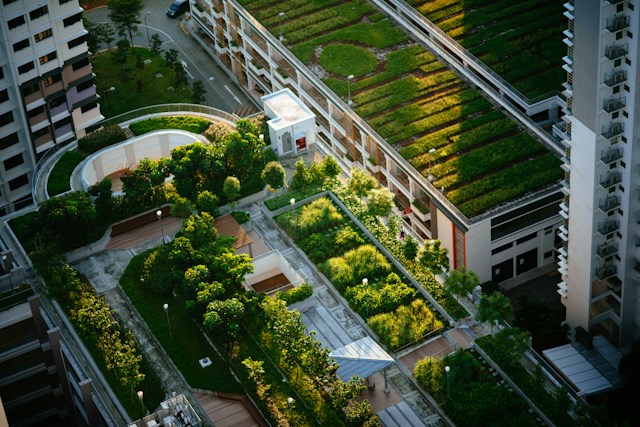As our cities continue to grow and evolve, the need for sustainable infrastructure capable of addressing a myriad of environmental challenges, including climate change, becomes increasingly critical. Green infrastructure, with its focus on incorporating natural systems into urban environments, presents a unique method for enhancing a city’s resilience to extreme weather events. By improving air quality, managing stormwater runoff, and reducing urban heat islands, green infrastructure provides cities with the necessary tools to adapt and thrive in the face of environmental change.
The Role of Green Infrastructure in Urban Climate Resilience
Before delving into the specific ways green infrastructure promotes resilience, it is important to understand what this term entails. Green infrastructure refers to the strategic integration of plants, soils, and other natural elements into urban areas to mimic the functions of natural ecosystems. This can range from green roofs and permeable pavements to urban forests and wetlands.
A lire également : How to choose a good tattoo artist ?
Green infrastructure plays an integral role in ensuring cities can withstand and recover from severe weather events, primarily due to its capacity for climate change adaptation and mitigation. By harnessing the power of nature, cities can create more sustainable, resilient urban environments that not only enhance the quality of life for residents but also protect them against the impacts of climate change.
The following sections will explore three key areas where green infrastructure contributes to urban climate resilience: air quality, stormwater management, and heat island effect reduction.
Dans le meme genre : What are the cultural implications of art therapy in diverse communities around the world?
Green Infrastructure and Improved Air Quality
Air quality is a critical determinant of public health in urban areas. Poor air quality, fueled by industrial emissions and vehicular pollution, can lead to a host of health issues, from respiratory conditions to cardiovascular diseases.
Green infrastructure, particularly urban forests and vegetation, can significantly improve air quality. Trees and plants act as natural air filters, removing harmful pollutants such as particulates, nitrogen dioxide, and ozone from the atmosphere. For instance, a mature tree can absorb up to 150kg of CO2 per year, effectively reducing greenhouse gas concentrations.
Additionally, greenery enhances the urban aesthetic, contributing to psychological well-being. Thus, by improving air quality, green infrastructure fosters a healthier, happier urban population, better equipped to cope with extreme weather events and the stresses associated with them.
Stormwater Management through Green Infrastructure
Stormwater runoff is a major concern in cities, particularly in the face of climate change, which is predicted to increase the frequency and intensity of heavy rainfall events. Built environments with large expanses of impervious surfaces, such as concrete and asphalt, exacerbate runoff, leading to flooding and water pollution.
Green infrastructure provides a sustainable solution for stormwater management. Features like green roofs, rain gardens, permeable pavements, and bioswales allow rainfall to infiltrate the ground, reducing runoff and relieving pressure on city sewer systems.
Moreover, by absorbing and filtering stormwater, green infrastructure helps to improve water quality. It removes pollutants from runoff before it enters our waterways, benefiting both human health and aquatic ecosystems.
Through efficient stormwater management, green infrastructure minimizes flood risks, protecting urban areas and their inhabitants from one of the most damaging impacts of extreme weather events.
Reducing Urban Heat Islands with Green Infrastructure
Another significant challenge cities face is the urban heat island effect, where urban areas experience higher temperatures than surrounding rural areas due to the prevalence of heat-absorbing surfaces like concrete and asphalt. This effect exacerbates heatwaves, posing significant risks to urban dwellers’ health and straining energy demand for cooling.
Green infrastructure plays a critical role in combating urban heat islands. Vegetation and green surfaces absorb less heat than conventional built surfaces, helping to lower urban temperatures. Green roofs and walls, parks, and tree-lined streets provide shade and release moisture into the air through transpiration, cooling the surrounding area.
By mitigating the urban heat island effect, green infrastructure contributes to a more comfortable, safer urban environment, enhancing resilience to heatwaves and other extreme temperature events.
In summary, by improving air quality, managing stormwater, and reducing heat islands, green infrastructure proves essential to reinforcing urban resilience to extreme weather events. By integrating nature into our cities, we can create sustainable, resilient urban environments capable of adapting and thriving amidst changing climate conditions. Despite the challenges arising from climate change, green infrastructure offers us a way forward, ensuring our cities remain vibrant, healthy, and resilient places to live.
Green Spaces and Mental Well-being
The contribution of green spaces to the mental well-being of city dwellers is an emerging area of interest in the field of urban planning and public health. As urban areas continue to expand, it is increasingly recognized that access to nature is not merely an aesthetic or recreational luxury, but a crucial component of overall health and happiness.
Green spaces such as parks, community gardens, and even street trees provide a multitude of benefits. In addition to their role in improving air quality and stormwater management, they contribute to mental health and social cohesion in ways that are less tangible but no less important.
Access to green spaces has been associated with reduced levels of stress, anxiety, and depression. The calming effect of nature can help individuals relax and recharge, providing a respite from the hustle and bustle of city life. The presence of greenery can also encourage physical activity, which is beneficial not only for physical health but also for mental well-being.
Furthermore, green spaces often serve as communal areas where people can interact and build relationships, fostering a sense of community and belonging. This social aspect is particularly important in densely populated urban areas where people might otherwise feel isolated.
In this way, green spaces enhance psychological and social resilience, equipping residents with the ability to cope with the stresses of extreme weather events and climate change. It’s another way that green infrastructure supports resilience within urban environments.
Green Roofs and Buildings: The Future of Urban Planning
The concept of green roofs is no longer a novelty but a significant aspect in the field of urban planning. A green roof is a roof of a building that is partially or completely covered with vegetation and a growing medium, installed over a waterproofing membrane.
Green roofs offer numerous benefits for urban areas. They provide additional insulation, which can reduce the need for heating or cooling, thereby saving energy and lowering greenhouse gas emissions. They also help manage stormwater runoff by absorbing and filtering rainfall, reducing the strain on city sewer systems.
Furthermore, green roofs can serve as habitats for urban wildlife, contributing to biodiversity within the city. They also add aesthetic value and can even serve as recreational spaces, contributing to the quality of life for building inhabitants and the surrounding community.
As cities continue to expand and the effects of climate change intensify, the importance of green roofs and buildings in urban planning cannot be overemphasized. By integrating nature-based solutions into our built environments, we can create cities that are not only more resilient but also more sustainable, livable, and vibrant.
Conclusion: The Path Towards Climate Resilient Cities
In conclusion, green infrastructure is a crucial tool in the fight against climate change and the quest for more resilient cities. By integrating natural systems into our urban environments, we can enhance air quality, manage stormwater effectively, reduce the urban heat island effect, promote mental well-being, and create more sustainable buildings.
As we gear up to face the environmental challenges of the 21st century, green infrastructure offers a way forward. It promises not just resilience in the face of extreme weather events, but also a better quality of life for urban inhabitants.
Ultimately, while the path towards climate resilience may be challenging, it is also an opportunity to rethink and redesign our cities in ways that are not only sustainable and resilient, but also more equitable and inclusive. Through thoughtful urban planning and the strategic use of green infrastructure, we have the potential to create cities that are prepared for the future, and that future can be as green as we make it.











